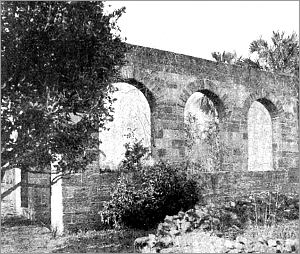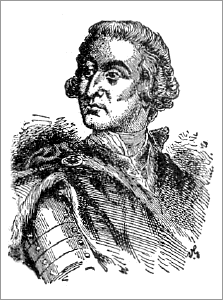| Home > Floripedia > English Settlers | |
English Settlers
A History of Florida1904
English Encroachments. It has been told how De Ayllon had in 1526 tried to make a settlement on the very spot where Jamestown was afterwards built, and how Menendez had sent two missionary parties to the Indians of the Chesapeake. But these attempts had been followed by failure, and for many years it was all the Spaniards could do to keep the colonies they had first planted in the South. Spain was no longer the powerful nation she had been at the time of the earlier voyages of exploration. So along the Atlantic coast from New England to Carolina, England had planted her colonies without hindrance from Spain. But when South Carolina was given a charter that fixed her southern boundary below St. Augustine, it was plain there would be trouble.
St. Augustine Plundered. St. Augustine had suffered from the English before now. Sir Francis Drake had struck a blow at Spain by burning the town, and in 1665 Captain Davis, an English freebooter, had plundered it. The fort was not finished, and the garrison made no resistance. Little wonder that the Spanish colonists were ill pleased at the coming of the new neighbors.
Hostilities. The English, on their side, had soon something to complain of, for the Spanish gave refuge to their runaway servants and prisoners, and had encouraged the Indians to make war on English settlers. In 1676 a small army from Florida attacked one of the English settlements, but was obliged to retreat. Ten years later another Spanish force took and plundered Port Royal, and destroyed many plantations. These things were not forgotten, and in 1702, England being at war with France and Spain, Governor Moore, of South Carolina, undertook an expedition against St. Augustine. He succeeded in driving the people into the fort and keeping them there three months, but the fort was too strong to be taken, and after burning the town he marched back home.
What change in the power of Spain bad occurred by the beginning of the eighteenth century? What encroachments upon their territorial possessions in Florida were occurring? What cause of complaint had the English?
Fort San Luis and Ayavalla Destroyed. This expedition having proved a failure and, Moore still longing to distinguish himself, he decided to march against the Spanish Indian towns of middle Florida. The most important of these was Fort San Luis, just two miles west of the present site of Tallahassee. Here twenty-three Spaniards and four hundred Apalachee Indians met a much larger force of English with their Creek allies. The Spanish commander, Don Juan Mexia, and about half his men were killed. The fort and the church, after being robbed of everything of value they contained, were destroyed. Ayavalla, a town on the St. Marks River, with its church, suffered the same fate. The other towns near by were so terrified that they offered to surrender. Governor Moore took captive a great many Indians as slaves. This, he said, was in return for the negro servants who had run away from South Carolina to Florida and been harbored.
Desolation of the Apalachee Region. A hundred years later Indian tradition still told the story of the terrible visitation. Traces of roads and bridges built by the Spaniards and the Indians, whom they bad done much to civilize, were still pointed out. Where villages, forts, and churches had been, only ruins remained, though many of the names still appeared on the maps. An old church bell was found near the Suwanee when the Americans took possession of Florida. It was all that remained of the little mission church, and the Indians looked upon it with awe and wonder, telling legends of how it had been brought among them so long before.
What were the first two warlike demonstrations between the colonies? Tell of the English retaliation under Governor Moore. What was done in Moore's first expedition? What in his Second expedition? What places were destroyed? What prisoners taken? What was the region visited?
It was this region desolated by Governor Moore that afterwards became the home of Indians from the territory north of Florida. Here the Seminoles came, though they later pushed their way as far south as the Alachua region.

Ruins of an Old Spanish MissionForts at St. Marks and Creve Coeur. After the English invasion the Apalachees were so reduced in numbers that their chief persuaded the governor of St. Augustine to build a fort at St. Marks on the Gulf for their protection. This was finished in March, 1718, and was called San Marcos de Apalachee. The Indians themselves built a little church near it. The same year the French built a fort at St. Josephs Bay, calling it Creve Coeur (Broken Heart). This after a few months was given over to the Spaniards.
What Indians afterwards occupied the middle Florida region?
Georgia Settled and Fortified. Hard pressed as Florida had been, it was still worse for her when Georgia, the last of the thirteen English colonies, was settled by Oglethorpe in 1733. The Georgia settlers built a fort on the Altamaha and another at Frederica on St. Simons Island. The Spanish government demanded the surrender of these forts, but Oglethorpe refused to give them up. Indeed, he prepared not only to defend them, but to attack St. Augustine.

OglethorpeWar with England. In 1739 war was declared between England and Spain. Then a squadron was sent to assist Oglethorpe, South Carolina joined forces, and a joint attack by land and sea was planned. There was a large body of Indian allies.
Siege of St. Augustine. About the last of May all these forces met near St. Augustine. The small forts were easily taken, then began the siege and blockade of St. Augustine. The people of the town were soon obliged to take refuge in the fort, and now the English hoped that the great number of hungry months to be fed would oblige a speedy surrender.
When, why, and by whom was St. Marks founded? What place Was established by the French 9 What still harder pressure was soon brought to bear upon Florida?
The Spanish governor, Don Manuel Moneano, was a man of great energy, and made the most of every means at his disposal, but the anxiety he felt is shown in a letter to the governor of Cuba. "Assure your lordship,"he wrote during the siege, "that it is impossible to express the confusion of this place, for we have no protection except the fort, and all else is open field. The families have abandoned their homes and come into the fort for protection, which is pitiable, although my only anxiety is the want of provisions; and if your lordship, lacking requisite force, cannot relieve us, we must certainly perish." The English knew of this distress and were confident of their own success.
But there was a change of fortune. On the night of the 25th of June a party from the fort sallied out and recaptured Fort Moosa. This bit of success gave great encouragement to the Spaniards. As the summer wore on, sickness broke out among the English; they became weary of the siege and longed to return home. Worse still, some deserted to the Spaniards. Yet the siege lasted until July 10. Then it was learned that vessels with provisions for the fort had reached Mosquito Inlet. This decided Oglethorpe to raise the siege and return home.
Invasion of Georgia. English deserters told Monteano that Oglethorpe intended returning the next spring. He did not do so, and Monteano decided to lead an attack against Oglethorpe's colony. A fleet was sent from Cuba to aid him, and with this force he entered the harbor of St. Simons July 5, 1742. The shore batteries opened a steady fire, but this did not prevent the fleet passing. Seeing this, Oglethorpe destroyed the fortifications at St. Simons and made haste to Frederica to meet the invaders.
Tell of the siege of St. Augustine in 1739. How was the siege raised?
On July 7, the Spaniards landed and began their march against Frederica. They had to pass over a very narrow cause way through a marsh. Here they were suddenly attacked, and in the battle lost four captains and more than two hundred men killed, besides many taken prisoners. This is known as the battle of "Bloody Marsh." Monteano was obliged to retreat, and as some English vessels appeared off the coast, he reembarked his troops for St. Augustine.
St. Augustine Challenged. In March, 1743, Oglethorpe suddenly appeared before the gates of St. Angustine and offered battle, but the garrison took no notice of his challenge, and he returned home. There were no regular battles, but neither was there any good will between the colonies. The English wrote of St. Augustine as "a den of thieves and ruffians! receptacle of debtors, servants, and slaves! bane of industry and good society!" while Monteano hoped that a day might come when he should " exterminate General Oglethorpe with all his forces.
Tell of the return invasion. Where did the expedition land? What was the objective point? How did it end? Tell of another English invasion of Florida.
Source:
Excerpt from Part One, Chapter Ten, "English Neighbors" A History of Florida, 1904. Next Section; Table of Contents.
| Home > Floripedia > English Settlers |
Exploring
Florida: A Social Studies Resource for Students and Teachers
Produced by the Florida Center for Instructional
Technology,
College of Education, University of South Florida © 2005.